UPSC Daily Current Affairs- 30th January 2023 | Current Affairs & Hindu Analysis: Daily, Weekly & Monthly PDF Download
GS-I
How do ruminants contribute to Methane Pollution?
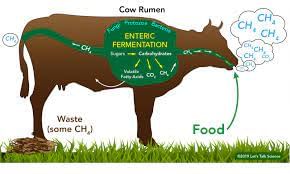
Context
Bill Gates has invested in a climate technology start-up that aims to curtail the methane emissions of cow burps.
What is the news?
- The startup Rumin8 is developing a variety of dietary supplements to feed to cows in a bid to reduce the amount of methane they emit into the atmosphere.
- The supplement includes red seaweed, which is believed to drastically cut methane output in cows.
What is Methane?
- Methane is a greenhouse gas, which is also a component of natural gas.
- There are various sources of methane including human and natural sources.
- The anthropogenic sources are responsible for 60 per cent of global methane emissions.
- It includes landfills, oil and natural gas systems, agricultural activities, coal mining, wastewater treatment, and certain industrial processes.
- The oil and gas sectors are among the largest contributors to human sources of methane.
- These emissions come primarily from the burning of fossil fuels, decomposition in landfills and the agriculture sector.
How do cows and other animals produce methane?
- Ruminant animals such as cows, sheep, goats, and buffaloes release this methane mainly through burping.
- They have a special type of digestive system that allows them to break down and digest food that non-ruminant species would be unable to digest.
- Stomachs of ruminant animals have four compartments, one of which, the rumen, helps them to store partially digested food and let it ferment.
- This partially digested and fermented food is regurgitated by the animals who chew through it again and finish the digestive process.
- However, as grass and other vegetation ferments in the rumen, it generates methane, a potent greenhouse gas.
How much do these ruminants contribute to emissions?
- Given the very large numbers of cattle and sheep on farms in dairy-producing countries, these emissions add up to a significant volume.
- It is estimated that the ruminant digestive system is responsible for 27 per cent of all methane emissions from human activity.
Why is methane such a big problem?
- Methane is one of the main drivers of climate change, responsible for 30 per cent of the warming since preindustrial times, second only to carbon dioxide.
- Over a 20-year period, methane is 80 times more potent at warming than carbon dioxide, according to a report by the UNEP.
- It’s also the primary contributor to the formation of ground-level ozone, a colourless and highly irritating gas that forms just above the Earth’s surface.
- According to a 2022 report, exposure to ground-level ozone could be contributing to 1 million premature deaths every year.
- Several studies have shown that in recent years, the amount of methane in the atmosphere has dramatically shot up.
Mitigating methane emissions
- Scientists have been working on to make these animals more sustainable and less gassy.
- A 2021 study, published in the journal PLUS ONE, found that adding seaweed to cow feed can reduce methane formation in their guts by more than 80 per cent.
- Apart from this, researchers are also trying to find gene-modifying techniques to curtail methane emissions in these animals.
- Last year, scientists in New Zealand announced they had started the world’s first genetic programme to address the challenge of climate change by breeding sheep that emit lower amounts of methane.
Global collaboration against methane pollution
Global Methane Initiative (GMI)
- GMI is a voluntary Government and an informal international partnership having members from 45 countries including the United States and Canada.
- India last year co-chaired along with Canada the GMI leadership meet held virtually.
- The forum has been created to achieve global reduction in anthropogenic methane emission through partnership among developed and developing countries having economies in transition.
- The forum was created in 2004 and India is one of the members since its inception and has taken up Vice-Chairmanship for the first time in the Steering Leadership along with USA.
Source: Indian Express
Munroe Thuruthu: Kerala’s Sinking Island

Context
A study conducted by the National Centre for Earth Science Studies (NCESS) has revealed anthropogenic interventions as the main reason for the sinking of Munroe Thuruthu Kerala’s, Kerala’s Sinking Island.
Note: This Island has nothing to do with Thomas Monroe, the erstwhile Governor of Madras Presidency (1820-27).
Munroe Thuruthu
- Munroe Thuruthu is an inland island group located at the confluence of Ashtamudi Lake and the Kallada River, in Kollam district of Kerala.
- The place is named in honour of Resident Colonel John Munro of the former Princely State of Travancore.
- It is a group of eight small islets comprising a total area of about 13.4 km2.
- This island is also known as “Sinking Island of Kerala”.
How was this island inhabited?
- In 1795 the British established their supremacy in South India and the princely state of Travancore came under their governance.
- From 1800 onwards, a Resident was appointed by East India Company as administrative head of Travancore.
- The first Resident was Colonel Colin Macaulay, followed by Colonel John Munro.
- During his tenure Munro oversaw the land reclamation efforts in the delta where Kallada River joins Ashtamudi Lake and the reclaimed island was named after him as Munroe Island.
Source: The Hindu
GS-II
All India Survey on Higher Education (AISHE) 2020-2021
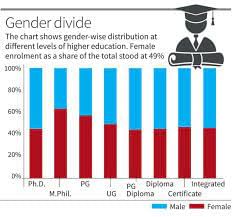
Context
Ministry of Education recently released All India Survey on Higher Education (AISHE) 2020-2021
About All India Survey on Higher Education (AISHE):
- It is conducted by the Ministry of Education since 2011.
- Coverage: It covers all higher educational institutions located in Indian Territory and imparting higher education in the country.
- Objectives:
- To identify and capture all the institutions of higher learning in the country.
- Collect the data from all the higher education institutions on various aspects of higher education.
- The survey collects detailed information on different parameters such as student enrollment, teacher’s data, infrastructural information, financial information etc.
Highlights of AISHE 2020-202:
- For the first time, in AISHE 2020-21, higher educational institutions have filled data using entirely online data collection platform through the Web Data Capture Format (DCF) developed by Department of Higher Education through the National Informatics Centre (NIC).
- Key Findings:
- The total number of Universities / University like institutions registered is 1,113, Colleges 43,796 and Standalone Institutions 11,296.
- Number of Universities has increased by 70, number of Colleges has increased by 1,453, in 2020-21 over 2019-20.
- Enrollment in higher education increases to 4.14 crore, crossing the 4 crore mark for first time; increase of 7.5% from 2019-20 and 21% from 2014-15.
- Female enrollment reaches 2 crore mark, increase of 13 Lakh from 2019-20.
- Gross Enrolment Ratio (GER) has improved from previous year for all social groups.
- Enrollment in Distance Education has increased by 7% in 2020-21 from 2019-20.
- Gender Parity Index (GPI) has increased from 1 in 2017-18 to 1.05 in 2020-21
Total number of faculty/teachers increases by 47,914 from 2019-20
Source: The Hindu
What are Padma Awards?
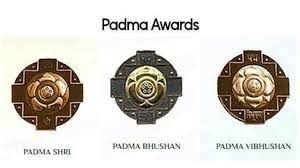
Context
Prime Minister urged the citizens of the country to read about the lives and stories of people who have been conferred with the prestigious 'Padma' Awards during his first 'Mann Ki Baat' radio programme of 2023.
Key facts about Padma Awards:
- The Padma Awards are one of the highest civilian honours of India announced annually on the eve of Republic Day.
- The award seeks to recognize works of distinction and is given for distinguished and exceptional achievements/service in all fields of activities/disciplines.
- Padma Awards were instituted in the year 1954
- The award is given in three categories, namely,
- Padma Vibhushan: for exceptional and distinguished service;
- Padma Bhushan: for distinguished service of a high order; and
- Padma Shri: for distinguished service.
- Award: The awardees are presented a Sanad (certificate) signed by the President and a medallion.
- Eligibility:
- All persons without distinction of race, occupation, position or sex are eligible for these awards.
- Government servants including those working with PSUs, except doctors and scientists, are not eligible for these Awards.
- The award is normally not conferred posthumously. However, in highly deserving cases, the Government could consider giving an award posthumously.
- The award does not amount to a title and cannot be used as a suffix or prefix to the awardees’ name.
- Who can nominate?
- Nominations are invited from Central Ministries/Departments, States/UT Governments, Bharat Ratna and Padma Vibhushan awardees, Institutes of Excellence.
- All citizens can make nominations/recommendation including self-nomination.
- Who Decides?
- All nominations received for Padma Awards are placed before the Padma Awards Committee, which is constituted by the Prime Minister every year.
- On the basis of the recommendations of the Awards Committee, and after approval of the Home Minister, Prime Minister and President, the Padma Awards are announced on the eve of the Republic Day.
Source: Indian Express
GS-III
What is a Spider Star System?
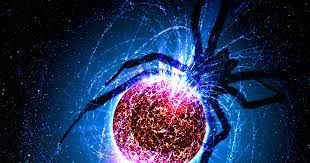

Context
Scientists at NASA have recently detected the first gamma-ray eclipses from a "spider" star system.
About Spider Star System:
- It is a binary star system in which a superdense star (pulsar) spins quickly, eats another star.
- The super-dense object that begins to pull a matter from the companion resembles the habits of spiders of the genus Latrodectus, in which the female eats the male after mating, hence the name came.
- Initially, the dense pulsar strips material from the outer atmosphere of its companion, periodically shedding the gathered material in violent explosions.
- In the later stage of their lifetimes, the energetic particles streaming out of the pulsar can strip the atmosphere of its companion.
- In either case, the pulsar slowly erodes its companion over time.
- Two Types:
- Black widows: Binary pulsar systems, in which the mass of a companion star is less than 5 percent of the pulsar.
- Redback: Binary pulsar systems in which mass of the companion star is from 10 to 50 percent of the pulsar.
What is a Binary star system?
- A binary system is one in which two stars orbit around a common centre of mass, that is they are gravitationally bound to each other.
What are pulsars?
- Pulsars are rapidly spinning neutron stars, extremely dense starscomposed almost entirely of neutrons and having a diameter of only 20 km (12 miles) or less.
- They emit concentrated streams of radiation far across the cosmos.
What are neutron stars?
- They are the remnants of giant stars that died in a fiery explosion known as a supernova.
- After such an outburst, the cores of these former stars compact into an ultradense object with the mass of the sun packed into a ball the size of a city.
Source: PIB
Domestic Goat as a Drug Factory
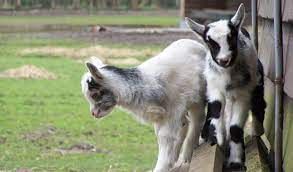
Context
India’s domestic goats have attracted the attention of biotechnology companies wishing to produce therapeutic proteins in bulk.
Domestication of Goats
- The domestic goat (Capra hircus) is a familiar presence in the rural landscape of India and in many developing countries.
- The goat has played an important economic role in human communities from the time it was domesticated about 10,000 years ago.
- It has even been argued that the domestication of goats was an important step in mankind’s shift from a hunting-gathering lifestyle to agricultural settlements.
Various breeds found in India
- The Food and Agriculture Organisation (FAO) estimates that the world has 830 million goats belonging to about 1,000 breeds.
- India has 150 million from over 20 prominent breeds including-
- Marwari: Rajasthan has the most number of goats — the Marwari goat found here is hardy and well-adapted to the climate of deserts.
- Osmanabadi: Another hardy breed, found in the dry regions of Maharashtra, Telangana and North Karnataka is the Osmanabadi.
- Malabari: Also called Tellicherry of North Kerala, it is a prolific breed with low-fat meat, and shares these traits with the beetal goat of Punjab.
- Black Bengal goat: The east Indian Black Bengal goat is a vital contributor to the livelihoods of the rural poor of Bangladesh. It contributes over 20 million square feet of skin and hides to the world’s demands for leather goods, from fire-fighters gloves to fashionable handbags.
- Jamunapari: These goats from Uttar Pradesh were favoured as they yield 300 kg of milk during eight months of lactation. Once in England, the Jamunapari was bred with local breeds to produce the Anglo-Nubian, a champion producer of high-fat milk.
Why are goats significant for farmers?
- Goats have a quick generation time of about two years.
- General benefits of goat milk out-powers the high-fat buffalo milk.
- As many farmers lack the space or funds to rear cattle, the goat is rightly called “the poor man’s cow”.
- There are no specific fodder requirements for goat. It can feed even on the neem leaves.
Significance in therapeutics: Antithrombin production
- Goats have attracted the attention of biotechnology companies wishing to produce therapeutic proteins in bulk.
- The first success came with ATryn, the trade name for a goat-produced antithrombin III molecule.
- Antithrombin keeps the blood free from clots, and its deficiency (usually inherited) can lead to serious complications such as pulmonary embolisms.
- Affected individuals need antithrombin injections twice a week, usually purified from donated blood.
- Recently, the monoclonal antibody cetuximab, which has been approved by the FDA as an anti-cancer drug against certain lung cancers, has also been produced in cloned goat lines.
Why is it a significant development?
- Transgenic goats carrying a copy of the human antithrombin gene have cells in their mammary glands that release this protein into milk.
- It has been claimed that one goat could produce antithrombin equivalent to what was obtained from 90,000 units of human blood.
- Large quantities can be made this way (10 grams per litre of milk).
Source: The Hindu
An international team of scientists recently made a breakthrough in retaining the quantum coherence of quantum dot spin qubits.
Context
An international team of scientists recently made a breakthrough in retaining the quantum coherence of quantum dot spin qubits.
About Quantum coherence:
- It deals with the idea that all objects have wave-like properties.
- It states that, if an object's wave-like nature is split in two, then the two waves may coherently interfere with each other in such a way as to form a single state that is a superposition of the two states.
- This concept of superposition is famously represented by Schrödinger's cat, which is both dead and alive at the same time when in its coherent state inside a closed box.
- It lies at the heart of quantum computing, in which a qubit is in a superposition of the "0" and "1" states.
What is Quantum entanglement?
- It means that aspects of one particle of an entangled pair depend on aspects of the other particle, no matter how far apart they are or what lies between them.
- Like coherence, quantum entanglement also plays an essential role in quantum technologies.
What is the principle of Superposition of waves?
- It states that when two or more waves overlap in space, the resultant disturbance is equal to the algebraic sum of the individual disturbances.
What is a qubit?
- A qubit (or quantum bit) is the quantum mechanical analogue of a classical bit.
- A classical binary bit can only represent a single binary value, such as 0 or 1.
- A qubit, however, can represent a 0, a 1, or any proportion of 0 and 1 in superposition of both states.
- In quantum computing the information is encoded in qubits.
Source: Indian Express
National IPR Policy: Discussing the rights of all the stakeholders

Context
In May 2016, the then Department of Industrial Policy and Promotion (now known as the Department for Promotion of Industry and Internal Trade) under the Ministry of Commerce released the 32-page National IPR Policy. The overall purpose of this document was to spell out the government’s comprehensive vision for the IPR ecosystem in the country towards shaping a more innovative and creative Bharat.
What is a Patent?
- A patent is an exclusive set of rights granted for an invention, which may be a product or process that provides a new way of doing something or offers a new technical solution to a problem.
Know the basics: Intellectual Property rights (IPR)
- IPR refers to the legal rights that protect an individual’s or company’s creations and inventions (such as inventions, literature, music, and symbols) from being used or copied by others without permission.
- IP is protected in law by, for example, patents, copyright and trademarks, which enable people to earn recognition or financial benefit from what they invent or create.
- By striking the right balance between the interests of innovators and the wider public interest, the IP system aims to foster an environment in which creativity and innovation can flourish.
Three important objectives of National IPR policy document
- Strong and effective IPR laws: Under the head Legal and Legislative Framework, the goal was to have strong and effective IPR laws, which balance the interests of right owners with larger public interest.
- Modernise and strengthen IPR administration: Under Administration and Management, the objective was to modernise and strengthen service-oriented IPR administration; and
- Strengthening adjudicatory mechanism: Under Enforcement and Adjudication, the focus was to strengthen the enforcement and adjudicatory mechanisms for combating IPR infringements.
Changes in IPR ecosystem so far
- Structural and legislative changes: Over the last six years, the IPR ecosystem in this country has witnessed both structural and legislative changes.
- Intellectual Property Appellate Board (IPAB): IPAB was dissolved in April 2021 as part of tribunal reforms, and its jurisdiction was re-transferred to high courts.
- Dedicated IP Division: This was followed by the establishment of dedicated IP benches the IP Division by the Delhi High Court, arguably the country’s leading court on the IPR front, for speedier disposal of IPR disputes.
- IP friendly environment: Such measures, one presumes, are intended to convey to investors and innovators that Bharat is an IP-savvy and even IP-friendly jurisdiction without compromising on national interest and public health commitments.
- For instance: This is evident from the very same National IPR Policy which, among other things, expressly recognises the contribution of the Indian pharmaceutical sector in enabling access to affordable medicines globally and its transformation to being the pharmacy of the world.
What are the concerns?
- Patent-friendliness, rather patentee-friendliness: It appears that the patent establishment of the country has drawn a very different message it has gone on an overdrive to prove its patent-friendliness, rather patentee-friendliness, in the pharmaceutical sector at the expense of public health and national interest respectively.
- Evergreening of patents on critical drugs: Evergreening patents on drugs which relate to treatment of diabetes, cancers, cardiovascular diseases and other serious conditions continue to be granted to pharmaceutical innovator companies by the Indian Patent Office.
- Enforcements at the expense of statutory rights: Worse, they are regularly enforced through courts at the expense of the statutory rights of generic manufacturers and to the detriment of patients.
- Unavailability of affordable drugs: The delayed entry of generic versions of off-patent drugs affects adversely the availability of affordable medicines to patients in a lower middle-income country such as Bharat where most middle-class families and below are only a hospital-visit away from dipping into their hard-earned savings.
Way ahead
- It must be understood that IP legislations such as the Patents Act do not exist for the sole benefit of IP right owners.
- Patent bargain is in which the society is expected to benefit from dynamic innovation-based competition between market players.
- Clearly, there are four stakeholders under the Patents Act the society, government, patentees and their competitors.
- Each of these stakeholders has rights under the statute which makes all of them right owners.
- To interpret, apply and enforce the Act to the exclusive benefit of patentees, and that too evergreening patentees, is to abridge and reduce to a naught the legitimate rights of other stakeholders, leading to sub-optimal and worse, anti-competitive market outcomes.
Conclusion
- It is one thing to operate under the understandable belief that Bharat needs to add layers to its IPR ecosystem to attract investment. However, it is entirely another to equate IPR-sensitivity with a pro-patentee position at the expense of public health obligations and long-term national interest. Make in India must be reconciled with Atmanirbhar Bharat, and in the event of conflict between the two, the latter must prevail for Bharat to retain its position as the pharmacy of the world.
Source: PIB
|
38 videos|5293 docs|1118 tests
|
FAQs on UPSC Daily Current Affairs- 30th January 2023 - Current Affairs & Hindu Analysis: Daily, Weekly & Monthly
| 1. What is the significance of GS-I, GS-II, and GS-III in the UPSC exam? |  |
| 2. How can I prepare for GS-I, GS-II, and GS-III in the UPSC exam? |  |
| 3. What are the important topics to focus on for GS-I, GS-II, and GS-III in the UPSC exam? |  |
| 4. Are there any specific current affairs sources that are recommended for preparing GS-I, GS-II, and GS-III in the UPSC exam? |  |
| 5. How can I improve my answer writing skills for GS-I, GS-II, and GS-III in the UPSC exam? |  |

















